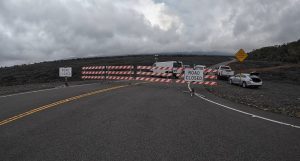
Periodically, this afternoon when clouds hugging the summit of the world’s largest volcano lifted, you could spot a field of lava on the northwestern flank of Mauna Loa.
The now 34-hour-long eruption of Mauna Loa has prompted the DLNR Division of Forestry and Wildlife (DOFAW) to close the Mauna Loa Forest Reserve and the Kipuka ‘Ainahou Nēnē Sanctuary for at least 90 days. DOFAW Hawai‘i Island Branch manager Steve Bergfeld has the discretion to close additional areas as needed that are impacted by the ongoing eruption. Additional closures announced tonight include ʻĀinapō Trail and cabin, and the Kapāpala Forest Reserve
Earlier today, officers from the Hawaii Police Department (HPD) and the DLNR Division of Conservation and Resources Enforcement (DOCARE) set up and began manning a roadblock at the intersection of Daniel K. Inouye Highway (Saddle Road) and the Mauna Loa Observatory Access Road.
Above the roadblock, Bergfeld got a glimpse of the lava flow which he estimated at about one-mile-long. Lava appeared to be flowing slowly from the mountain’s caldera, which is continuing to send large plumes of gas and ash high into the sky. Much of the 50,000-acre Mauna Loa Forest Reserve is covered in lava from previous eruptions.
Bergfeld and his staff are concerned that if lava begins flowing the opposite direction and into the Puʻu Makaʻala Natural Area Reserve, years of restoration work could be destroyed. Puʻu Makaʻala has been fenced to keep feral ungulates out to create habitat for numerous endangered Hawaiian forest birds and to re-establish native vegetation. It’s much too early to tell if the eruption is impacting other natural or cultural resources in the forest reserve. There are numerous other State forest reserves and natural area reserves on both sides of Mauna Loa. DOFAW teams will continue monitoring lava flows as they occur. Bergfeld says everyone’s top priority is protecting life and property.
